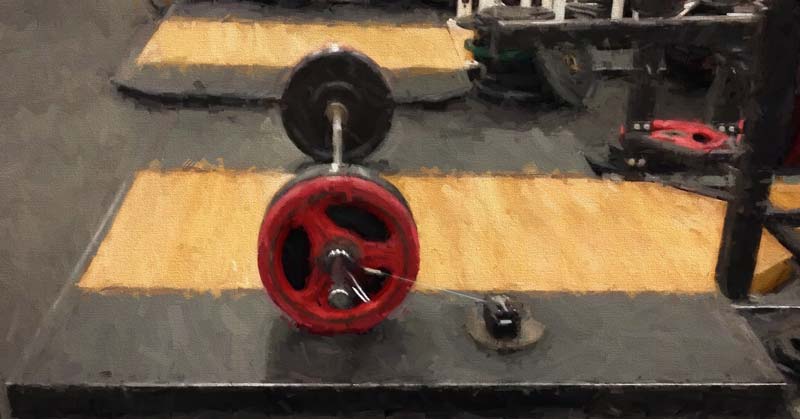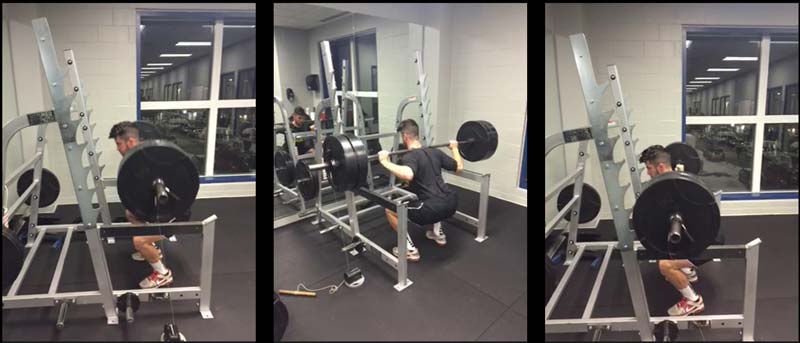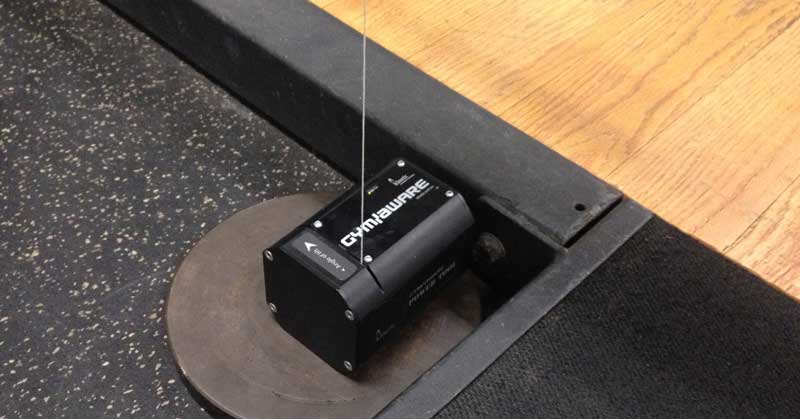
By Carl Valle
As someone who has used every device on the market, I place my priorities on what is important, not what is exciting. The boring reality is that most problems in the weight room are not new. In this article, I will address having more success in the weight room with bar tracking technology. The GymAware system is a great option for looking at the velocity of exercises, and displacement is a lesser-known but still vital measurement we need to do better with.
We pay considerable attention to bar velocity and exercise wattage, but not enough into sharpening the basic need of doing things right versus doing them with higher speeds or forces. For example, take the need to squat deeply, based on anatomy and skill level. We need to focus on doing the key core movements better early, then refine output as athletes evolve in training.
Displacement in the weight room: what, why, who, and when
Defining displacement is difficult as it covers a lot of movements. I looked at everything I did in the last ten years and compared it to what I have been doing since I started doing more bar tracking. What seems simple—like asking how deep one squats—was an easy answer years ago, as most referred to milestones such as “below parallel” or even “90 degrees.” At first glance, this is convenient, something simple we can refer to. But when things don’t work out with the simple we have to go back to the drawing board.
Displacement is a measurement of change between different starting and stopping points in time of exercises based on a static reference landmark.
I revised this summary several times before finally accepting it. The primary rationale is that it fits every exercise and forces coaches to ask what information they want to know about their program. What I had thought was a simple measurement or metric turned into a Cambrian explosion of important data.
Why should you want displacement, to see how distance and time create forces or control them? Work can be teased out, the technique can be properly evaluated, and even safety can be enhanced with bar displacement.
Athletes doing strength and power training can benefit by recording the displacement of their barbell stroke. Athletes without barbells can benefit as well. Many youth and aged athletes use dumbbells and sandbags to create external loading after they perform unloaded motions.
The best time to look at displacement is when athletes are introduced to formal training with loading and teaching, meaning exercises that develop athleticism outside teaching specialized or game-specific movements.
Athletes doing strength and power training can benefit by recording the displacement of their barbell stroke. Share on XWhat coaching or training benefits does bar displacement provide?
Now that the technical side is covered, let’s get down to business regarding what coaches want to know about the above information. I will boil down the needs to very explicit benefits with regards to bar displacement here.

Objective feedback and recording: Full and appropriate ranges have always been athlete perception versus coaching observation. While the data from coaches is likely to be strong enough, it’s always a matter of the athlete knowing versus coach telling and remembering. Bar tracking helps athletes see if they are doing what they are supposed to do, without creating negative subjective feedback from a coach.
Orthopedic health and management: Sometimes a movement may need to have specific ranges of motions to be mechanically safe to soft and hard tissue structures. Each athlete has a general biomechanical path that allows for effective and safe motion.
Workload scoring and typing: Work is a product of factors like distance, load, time, and other variables. Displacement during lifts can get muscle engagement estimations based on modeling and research. Surface EMG is important to consider if you want absolute information, but legacy research should guide basic exercises and give some helpful information.
The three big needs—following directions, safe movement, and sharper calculation of work—are essential. Simple displacement opens the door to a world of possibilities for coaches, sports medicine practitioners, and athletes.
Bar Displacement in Action with Squatting
The need to do barbell squats is something many strength coaches will be interested in whether they do front, back, or split squats. To me, it’s about getting the priorities mastered and performed properly. For illustrative purposes, we will use barbell front and back squats. When coaches use depth in coaching bilateral squats, they want the COM (center of mass) to drop. Increasing the distance the pelvis travels usually makes a more positive contribution to general performance, all else being equal. Most coaches want to squat deeply, and athletes sometimes can’t do that without excessive lumbar flexion and risk to the hips. How can you assess the best range of motion? My suggestion is to use the assessment of Dr. Stuart McGill and add bar displacement metrics to monitor consistency.
Step 1: Orthopedic Assessment
Squatting depth is more than just length of the torso and leg anatomy. It’s a complex yet elegant way of expressing body movement and mobility. From a legal perspective, I prefer the integration of measurements from a PT or ATC with good training knowledge instead of doing the assessment myself. Medical professionals need to more involved with athlete health while training, not just for injuries. Screening is always a crapshoot, but if you want to load the dice a bit squat properly.
Use video and measure the end ranges to see what type and depth of squatting pattern to use with the lower extremities. Understand that things change slightly with the addition of ground reaction forces and a barbell, so make sure you can convert that information to a weight-bearing squat pattern. Some neurological and motor skill changes occur, but we are looking for limits on joint patterns rather than coordinative limits.
Strength coaches should include the following data sets in their AMS platform or spreadsheet. It takes 10 minutes per athlete, but, believe me, it pays off tenfold over years of training.
- Pant inseam – The traditional measure of pant length
- Foot size – The standard foot measurement with or without socks
- Foot and tibia length – The length from below the kneecap and barefoot versus shod
- Standing width – The distance between medial ankle points when standing
- Squat width – The distance between medial ankle points when squatting
- Foot flare – How much external rotation in degrees one uses to squat
The FMS (Functional Movement Screen) has taken a beating lately, but let’s be clear about the value of using unloaded exercises you plan to load. For years, I have used the overhead squat. I use that motion in addition to the traditional front and back squats to help assess how athletes respond to exercise patterns. A baseball team doesn’t try to predict UCL injury in pitchers with a squat indirectly; they try to make sure their squats are better directly! I video the exercise from the side and back and score that data in degrees with Dartfish. Then I merge the medical data with the exercise information.

The result of all this is the safe range of motion athletes can do in a general squatting pattern (orthopedic) and what happens when they are on their feet with an exercise appraisal. In the past, I just watched carefully. But this information is instantly vertical. You get what you need to know immediately.
Step 2: Exercise Setup
In the early 2000s, I attended the SWIS and EliteFTS conference and seminar for proper squatting procedures. Jim and Dave hurt my feelings each time but were patient and added considerably to my coaching knowledge. I was never a power lifter nor had experience with Olympic-style lifts in high school and college, so I was merely competent and safe. I wanted more. I learned the importance of setting up the exercise and doing the details of respecting the exercise at all loads. Most people might think Jim and Dave cared only about heavy loads, but they made sure the expectations were high on the warmup with just a light load as well.
Their motto was “Treat heavy weights like they are light, and light weights like they are heavy.” What is important is instilling a consistent, repeatable approach to doing the exercise no matter what the load. Why? Repeatability increases the safety of the exercise and offers a better environment to assess change. If an exercise modifies stance or bar placement, the data changes and so does its interpretation. If it weren’t for those two workshops in Toronto and Boston, my current data would be tainted.
Step 3: Coaching assistance
Merging the medical and teaching screening to loaded assessment is the third and hardest step to do as it adds to the rubber hitting the road of the athletes putting it together. Having them use the range of motion they are given genetically, applying the procedure of starting and ending the exercise faithfully, and repeating the pattern with load is the goal. Coaches must reinforce and guide their athletes in the little nuances of squatting or executing the exercise.
Coaches want to see if athletes hit their motions via eyeballing the pattern and making sure it looks what is expected. Sometimes the movement may increase range, but a lot of coaching is ensuring what athletes can do is repeated over and over again.
Athletes make three classic errors when they are loaded and squatting. These errors can occur anywhere and at any level.
- Change in lifting strategy – Looking for a better number (pounds on the bar), athletes change their technique to get a mechanical advantage. Coaches want better transfer of increased muscular work, not better numbers from changing the motion. Athletes need to remember that the goal of lifting is to improve performance, and lifting sports are about improving numbers.
- Change in torso position – Sometimes less-skilled athletes will bend more at the torso because they perceive they are moving their center of mass lower. But they are simply bowing. Bar-tracking technology can pick up a little discrepancy, but the lack of depth doesn’t provide the same stimulus.
- Decrease in range or change in speed – Sometimes athletes are afraid to get stuck in the hole or simply feel unsafe squatting deep when the load increases. They may fight the depth and shorten up the stroke or pop a little to cheat on technique. While work may be similar to a faster descent, athletes must show control. So I don’t like bouncing in general.
The goal of the coach is to ensure that change only occurs on the scale, not on the exercise. We want to increase weight without changing anything besides effort through the feet.
Step 4: Long-term Analysis
Long-term analysis on squatting depth and general displacement throughout the season is awesome. While I have used barbell squats as the example, it’s relevant to all exercises, not just one movement. As a fan of Tom Tellez, I use the word stroke to replace the barbell or exercise motion length or action. Here are a few examples from the community of coaches.
Relationship between exercise weight and range performance
Simple observation of one exercise and execution over time is a great lesson in strength training. Does the athlete do the same stroke over time, even when the weight increases? This is not just as simple as the distance of the stroke. Some athletes use depth as an advantage, such as bouncing off the chest in bench presses. A tiny and simple variable of motion distance and the context of the displacement is extremely valuable. Repetition tempo and sticking points based on distance are all very telling of what is happening
Relationship between program phases and performance
Another area of interest is seeing how different phases of an exercise show ranges of motion. Some exercises are concentric influenced, like pulls and shallower versions of the Olympic lifts such as power cleans. It would be interesting to see how the sum of bar displacement during each phase of the general lifting program shows up in other areas. Obviously, this type of analysis requires more time, but I find that harmony over a season means contrasting training by balancing out the scores every week or even mesocycles. Sometimes the range of motion of exercises is interesting to see with injury patterns and eccentric strength.
Relationship between anatomical factors and exercise modes
The value of seeing simple comparisons like right and left leg in reverse leg pressing or split squat asymmetries may provide evidence of bad habits or injury. Sometimes left and right asymmetries don’t lead to a finite conclusion, but knowing patterns over time do matter. Athletes may train for years, and all of the reps add up to great results. But sometimes they add up to problems if not carefully watched. One example is major differences in leg power with cross-sectional asymmetries.
Over time, some athletes may create changes in mobility and specific strength from program design of exercises, so the taxonomy of different movements in the weight room matters. I suggest seeing how structural balance distributes the work properly and reduces pattern overload.
Putting bar tracking to motion with displacement scoring
My goal here is to explain how those in the iron game can get more out of their data, not do more unnecessary analysis or statistical breakdown. With coaches having less margin for error, marginal gains only make sense when they show up with big improvements over time. The process of getting more from VBT products that can accurately measure barbell or motion displacement can start with a small step. As you become more comfortable each year, add more analysis to whatever you feel will help your athletes.
Sometimes doing the basics better matters, sometimes mining the data and finding little ways to get better results is the answer, and sometimes just making sure everyone is fairly evaluated with objective information is best. I am a huge fan of doing the tried and true activities sharper and more refined. Using tools that can remove the guesswork and passively collect information saves time. Over the last few years, I have learned a lot from trying to do a better job. I am confident you will enjoy more success in your program with the right information.
Please share so others may benefit.
[mashshare]


Are there any good data sets for bar displacement or distance in barbell movements relative to height?